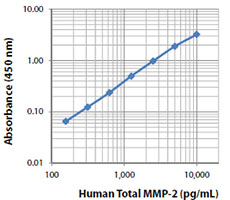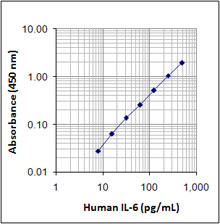- Regulatory Status
- RUO
- Other Names
- Matrix Metalloproteinase 9, Gelatinase B, 92kD Type IV Collagenase, CLG4B
- Ave. Rating
- Submit a Review
- Product Citations
- publications
| Cat # | Size | Price | Quantity Check Availability | Save | ||
|---|---|---|---|---|---|---|
| 444907 | 1 Pre-coated Plate | 370€ | ||||
Matrix metalloproteinase 9 (MMP-9), also known as gelatinase B or 92 kD type IV collagenase, belongs to the family of MMPs, which are zinc-dependent enzymes whose primary function is to degrade extracellular matrix proteins. MMP-9 is generally secreted as an inactive 92 kD pro-form by many cell types, notably neutrophils, monocytes, macrophages, endothelial cells, platelets, and tumor cells. A cysteine residue in the pro-domain coordinates with zinc in the catalytic domain to confer latency. When the pro-domain is cleaved off by other proteases, such as MMP-3, the enzyme is activated and forms its typical 82 kD mature form. An atypical 65 kD mature form also exists that lacks the hemopexin domain.
MMP-9 is the only MMP that can form homodimers, and both pro- and mature homodimer forms can exist. MMP-9 can also interact and bind to a multitude of other proteins. For example, tissue inhibitor of metalloproteinase 1 (TIMP-1) is its natural inhibitor. Other binding partners include CD44 and neutrophil gelatinase-associated lipocalin (NGAL).
MMP-9 is most closely related to MMP-2, with which it shares only 46% amino acid sequence identity overall. Across species, human MMP-9 shares 82-99%, 75%, and 72% amino acid sequence identity with non-human primate, rat, and mouse MMP-9, respectively.
MMP-9 plays important roles in inflammation, wound healing, tissue remodeling, cell migration, and tumor growth and metastasis. It is a potential biomarker for many diseases and conditions, often with elevated levels seen in various cancers, inflammatory conditions, allergies, autoimmune diseases, and myocardial infarction.
The LEGEND MAX™ Human MMP-9 Sandwich Enzyme-Linked Immunosorbent Assay (ELISA) kit includes a 96-well strip plate that is pre-coated with a mouse monoclonal anti-human MMP-9 antibody. The Detection Antibody is a biotinylated mouse monoclonal anti-human MMP-9 antibody. This kit is specifically designed to accurately measure MMP-9, including monomeric and dimeric pro-MMP-9, MMP-9/NGAL complex, and MMP-9/NGAL/TIMP-1 complex. This kit has been analytically validated to assess cell culture supernatant, urine, saliva, serum, and plasma samples with ready-to-use reagents.
Kit Details
- Kit Contents
-
- Anti-human MMP-9 Pre-coated 96-well Strip Microplate
- Human MMP-9 Dectection Antibody
- Human MMP-9 Standard
- Avidin-HRP
- Assay Buffer A
- Wash Buffer (20X)
- Substrate Solution D
- Stop Solution
- Plate Sealers
- Materials Not Included
-
- Microplate reader able to measure absorbance at 450 nm
- Adjustable pipettes to measure volumes ranging from 1 µL to 1,000 µL
- Deionized water
- Wash bottle or automated microplate washer
- Log-Log graph paper or software for data analysis
- Tubes to prepare standard dilutions
- Timer
- Plate Shaker
- Polypropylene vials
Product Details
- Verified Reactivity
- Human
- Application
-
ELISA
- Application Notes
-
This kit detects MMP-9 with better sensitivity than other kits on the market with the same diversity of valid sample types. The dynamic range of this kit is 0.25-16 ng/mL, while the dynamic range of an equivalent kit from a major competitor is 0.313-20 ng/mL. The overall sensitivity of this kit is 0.062 ng/mL soluble human MMP-9, while an equivalent kit from a major competitor has a sensitivity of 0.156 ng/mL.
- Product Citations
-
- Sensitivity
- 46.9 pg/mL
- Standard Range
- 250-16,000 pg/mL
- Materials Not Included
-
- Microplate reader able to measure absorbance at 450 nm
- Adjustable pipettes to measure volumes ranging from 1 µL to 1,000 µL
- Deionized water
- Wash bottle or automated microplate washer
- Log-Log graph paper or software for data analysis
- Tubes to prepare standard dilutions
- Timer
- Plate Shaker
- Polypropylene vials
Antigen Details
- Cell Sources
- Neutrophils, monocytes, macrophages, endothelial cells, platelets, and tumor cells.
- Biology Area
- Angiogenesis, Cell Adhesion, Cell Biology, Neuroinflammation, Neuroscience
- Molecular Family
- Enzymes and Regulators
- Gene ID
- 4318 View all products for this Gene ID
- UniProt
- View information about MMP-9 on UniProt.org
Related Pages & Pathways
Pages
Related FAQs
- In your LEGEND MAX™ ELISA Kits, there is a step that calls for washing the plates before adding sample. What is the purpose of this step?
-
We typically use a stabilizer for pre-coated plates. The additional washing step is designed to remove these components before you start the assay. If you do not perform the washing, the effect on assay performance is negligible.
- I have multiple LEGEND MAX™ ELISA kits that I want to run simultaneously. Can I use the same wash buffer for all the kits?
-
The wash buffer provided in all our LEGEND MAX™ kits is the same and the part numbers on the wash buffer bottles in these kits should be identical. For ELISA MAX™ Deluxe and ELISA MAX™ Standard Sets, we provide a recipe for the wash buffer on each kit’s technical data sheet. This recipe is the same for all ELISA MAX™ sets.
- For some of your ELISA kits, why do my serum samples require dilution with assay buffer?
-
In some cases, dilution with assay buffer is required to minimize the matrix difference between the samples and the standards to achieve better accuracy.
 Login / Register
Login / Register 












Follow Us